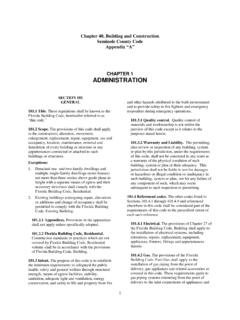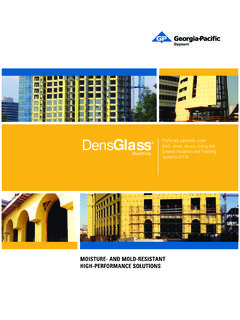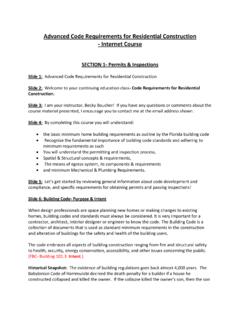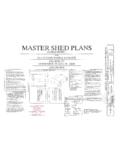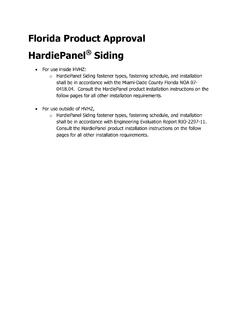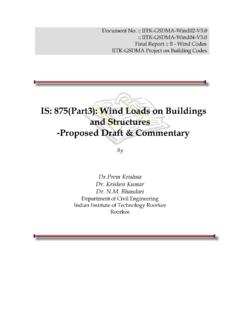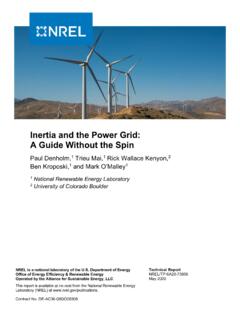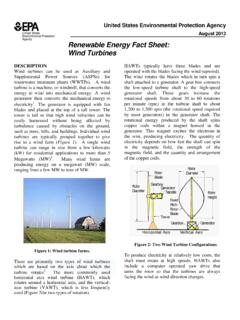Transcription of WIND LOADS IMPACTS FROM ASCE 7-16 - Florida Building
1 wind LOADS IMPACTS FROM ASCE 7-16 June 2020 CHANGES TO wind LOADS IN THE 7TH EDITION (2020) Florida Building CODE, Building AND RESIDENTIAL IMPACTS FROM ASCE 7-16 American Society of Civil Engineers ASCE 7-16 The 7th Edition (2020) Florida Building Code, Building (FBCB) and Florida Building Code, Residential (FBCR) have been updated to reference ASCE 7-16 Minimum Design LOADS and Associated Criteria for Buildings and Other Structures. Accordingly, the wind criteria in the 7th Edition FBCB and FBCR have been updated to correlate with ASCE 7-16.
2 ASCE 7-16 includes a number of notable changes to the wind load provisions. A few key changes are identified as follows and are summarized in this fact sheet: New Risk Category IV wind speed map New wind load criteria for rooftop solar panels Revised (higher) design wind pressures on roofs of buildings with mean roof height 60 feet New wind load criteria for attached canopies New guidance in the commentary for designing for tornadoes New Risk Category IV wind Speed Map 7th Edition (2020) FBCB (ASCE 7-16 Figure )
3 While the wind speed maps in ASCE 7-16 have been revised significantly for the nonhurricane-prone region, for the State of Florida , the only significant change to the wind speed maps is the introduction of a new wind speed map for Risk Category IV buildings and structures. wind speeds for Risk Category I, II, and III buildings are unchanged from the 6th Edition (2017) FBCB. In the 6th Edition (2017) FBCB (and ASCE 7-10), wind speeds for Risk Category III and IV buildings were the same and provided on a single map.
4 However, Risk Category III and IV represent different levels of risk as Risk Category IV includes essential facilities whose failure could pose a substantial hazard to a community if they failed. The addition of a new wind speed map specific to Risk Category IV buildings and structures recognizes the higher reliabilities required for these buildings and structures. The Risk Category IV wind speed map is based on a mean recurrence interval (MRI) of 3000 DISCLAIMER This piece is intended to give the reader only general factual information current at the time of publication.
5 This piece is not a substitute for professional advice and should not be used for guidance or decisions related to a specific design or construction project. This piece is not intended to reflect the opinion of any of the entities, agencies or organizations identified in the materials. Any opinion is that of the individual author and should not be relied upon. Significant Changes to ASCE 7-16 A comprehensive review of all changes to ASCE 7-16 including dead, live, snow, and earthquake LOADS can be found in Significant Changes to the Minimum Design load Provisions of ASCE 7-16 published by ASCE.
6 2 years. While the impact of the new of Risk Category IV wind speed map varies throughout the state, wind speed increases for Risk Category IV buildings range from 2% to 6% throughout compared to the 6th Edition (2017) FBCB. FIGURE (3) ULTIMATE DESIGN wind SPEEDS, VULT, FOR RISK CATEGORY IV BUILDINGS AND OTHER STRUCTURES NOTE: Because the FBCR only addresses one- and two-family dwellings and townhouses (Risk Category II buildings and other structures) the new Risk Category IV wind speed map was not added to the FBCR.
7 The wind speed map in the FBCR is unchanged from the 6th Edition (2017) FBCR. In the High-Velocity Hurricane Zones, where a single wind speed for each Risk Category is specified for Miami-Dade County and Broward County, the applicable Risk Category IV wind speeds are as follows: Miami-Dade County Risk Category IV Buildings and Structures: 195 mph Broward County Risk Category IV Buildings and Structures: 185 mph The addition of a separate wind speed map for Risk Category IV Building and structures also required a tweak to the definition of the wind -borne Debris Region (WBDR) in the FBCB.
8 The WBDR for the Risk Category IV buildings and structures is now based on the new Risk Category IV wind speed map which will result in a moderate increase in the WBDR for Risk Category IV buildings and other structures compared to the 6th Edition (2017) FBCB. Section 202 in the FBCB wind -BORNE DEBRIS REGION. Areas within hurricane- prone regions located: 1. Within 1 mile ( km) of the coastal mean high water line where the ultimate design wind speed, Vult, is 130 mph (58 m/s) or greater; or 2.
9 In areas where the ultimate design wind speed, Vult, is 140 mph ( m/s) or greater. For Risk Category II buildings and other structures and Risk Category III buildings and other structures, except health care facilities, the wind -borne debris region shall be based on Figure (1). For Risk Category III health care facilities, the wind -borne debris region shall be based on Figure (2). For Risk Category IV buildings and other structures, the wind -borne debris region shall be based on Figure (3).
10 Important Note Regarding the Use of Site-Specific wind Speed Websites The ATC Hazard By Location ( ) and the ASCE Hazard Tool ( ) websites are commonly used to obtain site-specific wind speeds. While the 7th Edition (2020) FBC has adopted ASCE 7-16, Florida -specific changes to two of the wind speed maps will make the hazard tool unreliable for some areas of Florida . The 7th Edition (2020) FBC retained the ASCE 7-10 Risk Category II map, because the ASCE 7-16 Risk Category II map reduced wind speeds in the Big Bend area.
